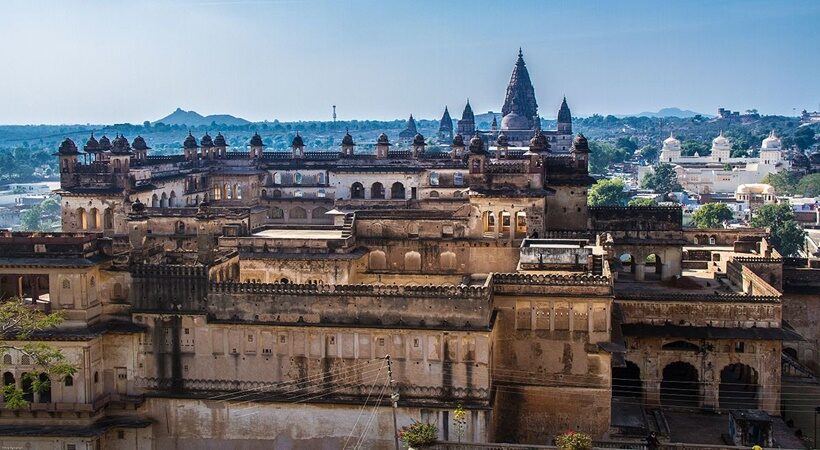Situated just 12 kilometres from Jhansi, the historic city of Orchha invites the visitors to immerse themselves in splendid architecture comprising of beautifully sculpted monuments, temples, palaces and cenotaphs. Established in 1531 by the Bundela chief Rudra Pratap Singh as the new capital of the kingdom of Bundelkhand, Orchha is home to unique architectural motifs coupled with legends of Bundela royalty.
With a distinct blend of Mughal and Rajput architecture, the city offers surprising structures such as the Ram Raja Temple, which was a former palace of Queens, or Chaturbhuj Temple having a 334 ft. Vimana. The town seems frozen in time with many monuments continuing to retain their original grandeur to this day.
Orchha Fort and Jehangir Mahal

Image Credits: Wikipedia
Orchha fort complex houses many palaces including Jehangir Mahal, Raja Mahal, Sheesh Mahal and Rai Praveen Mahal. Situated on an island in the Betwa river, one can reach the fort from the town through a granite stone bridge with 14 arches. The main attraction of Orchha fort is Jehangir Mahal, which has 236 rooms and a big central courtyard. It was built by the Bundela king Vir Singh Deo as a symbol of his friendly alliance with Mughal Emperor Jehangir on his visit to the region.
The Mahal has a unique blend of Mughal and Rajput architecture and has an imposing entrance, big enough to accommodate war elephants. There are various fine paintings on walls and ceilings using vegetable colours. The palace is situated at the highest point in the fort complex and overlooks the whole town and Vindhya range across the two branches of the Betwa river encircling the fort.
Ram Raja Temple and Chaturbhuj Temple

Image Credits: Wiki Commons
Ram Raja temple has a unique distinction of housing Ram as King rather than a god. The temple was originally a Ranivaas or queen’s palace. Local legends have it that the Queen of Orchha was a big devotee of the deity, and she invited Rama from Ayodhya to Orchha. She commissioned the huge Chaturbhuj Temple in his honour.
The temple was built in such a manner that the queen could see the temple from her Palace’s window. But before agreeing to move to Orchha, there was a condition from the deity that he would remain in the place where he would be first brought. When Queen reached Orchha, the Chaturbhuj temple was still under construction, so she requested the statue of the deity to be placed in the Palace next to the temple. Afterwards, when they tried to move the idol, it was impossible to move. As a result, the palace became the residence of Ram and is currently known as the Ram Raja Temple.
The Chaturbhuj Temple built by King Madhukar Shah and King Vir Singh Deo of Orchha is famous for having one of the tallest Vimanas among Hindu temples. It towers in the skyline of Orchha town, standing at 344 feet.
Orchha Chhatris

Constructed in honour of the rulers of Orchha, these 15 cenotaphs are located on the southern bank of the Betwa River. Most of these unique structures are designed in a three-story pattern and well-preserved. Chhatris or Cenotaphs are the memorials of rulers and other important figures. The most known cenotaphs are those of King Vir Singh Deo Bundela, Jaswant Singh, Udait Singh, Pahar Singh and others. The chhatris of Orchha are constructed in Panchaytan style. Located on the Kanchan Ghat, these chhatris are frequented by most travellers to get a glimpse of mesmerizing sunrise or sunsets.



















